THE LOST HISTORY OF FELDMAN’S ARCADE AND THE MUSIC PIONEER WHO GAVE IT HIS NAME
by

How many thousands of holiday makers visiting Blackpool have walked past this building over the years and have gazed upwards at the once magnificent façade of Feldman’s Arcade without realizing its importance as a musical monument from a bygone era.
Situated in a prime location directly adjacent to the iconic Clifton Hotel on the promenade Feldman’s Arcade was an early 1920’s live music emporium with vibrant music parlors and song booths where musicians and singers would demonstrate songs and musical compositions to a captive audience who thronged the promenade in those heady days when song sheet hits of the day could be purchased for at least sixpence. Encouraged by “shills” who were ‘planted’ in the audience by the Arcade’s management they persuaded the crowds to sing along and then buy the songs by waving ‘dummy purchases’ in the air. It was a tried and tested slightly underhanded practice but it worked well in large crowds and increased the sales turnover on sheet music.
Feldman’s Arcade Café on the upper floors offered a more sedate musical rendezvous with light classical music recitals, bar mitzvahs and private society functions. Fred Ash’s photographic studio was also located within the Arcade.

“Happy Days In Blackpool” 1926 at Feldmans on Central Pier. The song they are dancing along to is “Brown Eyes Why Are You Blue” also recorded in 1925 by Nick Lucas. “Happy Days In Blackpool” You Tube link www.youtube.com/watch?v=cT00YvCEhXs

Feldman’s Arcade was once described as Blackpool’s ‘Tin Pan Alley’ by my father who remembered it as it was in the 1920’s, when he first visited Blackpool as a representative for Cramer’s Music. The Arcade was the headquarters and lynchpin of the resort’s operations for London music publisher and impresario Bert Feldman who operated song booths and retail outlets on “the golden mile” and the piers.
Feldman who had other sites in holiday resorts around England and the Isle of Man purchased ‘The Borough Theatre’ in Bank Hey Street, Blackpool in 1928 giving him a further foothold in the entertainment business. The Borough was renamed as “Feldman’s Theatre” but it was demolished in 1972, which may account for the confusion by those who have recently speculated mistakenly that Feldman’s Arcade was also once a theatre.
Feldman & Co Music Publishers were in the ascendancy in the 1920’s as a burgeoning Shaftsbury Avenue music publishing house and an entertainment organization which produced ‘Felmandism’ it’s own monthly music trade magazine to promote new songs to band leaders and record companies. B. Feldman & Co also purchased publishing rights from Herman Derewski who was a light orchestral composer and bandleader who performed many times in Blackpool in the 1920’s & 30’s with his Melody Band.
Herman Derewski was better known for his musical score for the stage play “The Better Ole”, a light hearted story by Bruce Bairnsfather & Arthur Eliot about the exploits of the immortal “Old Bill” in the trenches of The First World War. My uncle, actor Sydney King made his debut in one of the early stage productions having joined up for army service at the outbreak of the war aged only fourteen!
A song sheet from Charles Cochran’s stage production and “Better ‘Ole” sheet music by Composer Herman Darewski inset with actor Sydney King in army uniform who appeared in an early stage production of “The Better ‘Ole”
It was the entrepreneurial spirit within Bert Feldman which guided him to become the first ‘song plugger’ and ‘hands on’ music seller in Britain, helping to rejuvenate an antiquated music business totally dependent on music halls for song exposure. Feldman’s aggressive marketing techniques ‘broke the mold’ and forged the foundations of a commercial music industry in Britain.
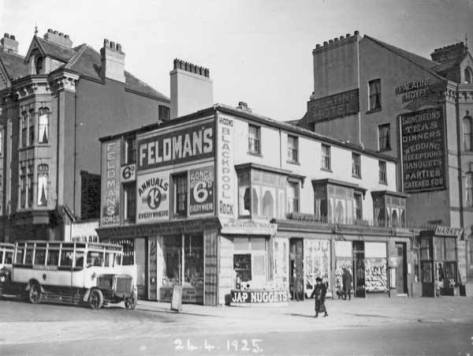
The West End of London was the centre of the music publishing world in Britain with each publisher employing ‘in house’ songwriters & composers, but it was Blackpool that had its ‘finger on the pulse’ becoming the stamping ground for so many new songs with its numerous song booths, music arcades and theatres. It must be remembered that this was the pre multi broadcast era where new songs had no mass media outlets and songwriters and publishers were entirely reliant upon live performances to promote their music. Music publishing was a highly competitive business, with big financial rewards for the publishers as song contracts in those days were drawn up heavily in the favour of the Publisher, whose return was very often twenty five times more than the writer.

Feldman was the first British music publisher to visit New York’s “Tin Pan Alley” in 1907 before the First World War and was shrewd enough to have obtained sub publishing rights for American hit songs in Britain, also proving himself to be a ‘new music pioneer’ by promoting American Ragtime music in England, much to the displeasure of the conventional music establishment. Feldman visited New York again on business in 1912 sailing on the RMS Olympic just one month after the Titanic disaster. Feldman brought million selling songs to Britain including “A Bird In A Gilded Cage”, “Alexander’s Ragtime Band” and “The Teddy Bears Picnic” which he updated by employing lyricist Jimmy Kennedy to write a story line for the song. This was one of Feldman’s great strengths to take an instrumental tune and reinforce the melody with lyrics.
The most important song signing was “It’s A Long Long Way To Tipperary” written by Jack Judge & Harry Williams, It was a sentimental song which was adapted into a marching theme by Feldman and became the most successful song in Feldman’s music publisher’s portfolio, after having been rejected by all the other major London publishers, It went on to sell eight million copies and became the most famous marching song of the First World War.

Feldman himself reflected that inducing music hall entertainer Florrie Forde to perform it in the Isle of Man 1913 was the turning point, saying that “to my mind this was the ‘ psychological moment’ in it’s career, for its success was electrical and thousands of visitors took it and made it their own”.
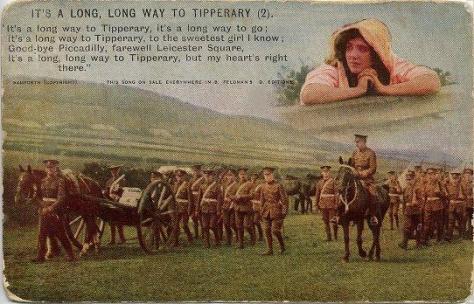
“This song for sale everywhere in B Feldmans D Editions”

Variations’ of the “Tipperary” theme for piano in 1915
This memorable song offers an intangible portal to the emotions of the past and connects us to the nostalgia that period. The forthcoming First World War Centenary commemorations will no doubt inspire historians to re appraise the feelings and sentiments of that time and no one could have encapsulated it more perfectly, as the spirit of the soldier is immortalised within this marching anthem. Feldman had the foresight to see the full potential of this song, but it was only through his astute marketing skills that the song achieved international recognition. Feldman’s ambition and tenacity enabled him to expand his publishing empire from its more humble beginnings when he first arrived in London in 1895 with just three pounds to start his music business. The Yorkshire born music publisher broke with convention and official regulations in 1912 by using his own image on Feldman’s mechanical copyright stamps which were also used on 78 rpm records.
Feldman’s Music Publishers mechanical copyright stamps http://www.78rpm.net.nz/mechcopy/Book/F.pdf

Lawrence Wright aka Horatio Nicholls music publisher, impresario and founder of music newspaper ‘Melody Maker’ was Feldman’s main competitor in Blackpool and also had song booths around the resort in Bank Hey Street next to RHO Hills Department Store and a large arcade on the ‘Golden Mile’ near Tussauds Waxworks. He employed singers like Roberta Dexter and backing musicians using the same format as Feldman to demonstrate his songs, many of which he had composed himself under the name of Horatio Nicholls and other ‘nom de plumes’. It is remarkable to think that Blackpool was considered so important to both publishers that they based themselves in the town, and both died there. Lawrence Wright died in 1964 and Bert Feldman much earlier in 1945. Feldman is listed on the 1939 census as living at 14 Second Avenue, South Shore, my search for his Blackpool residence was made more difficult as the enumerator appears to have misspelt his name as ‘Fieldman’.
According to ‘The Sydney Morning Herald’ friends of Bert Feldman declared he had left a personal fortune of £2,000,000, whilst other newspapers quoted a more conservative figure of £488.000.

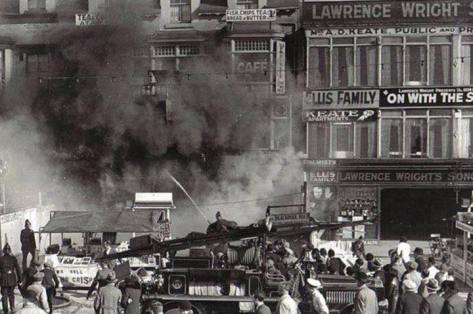
After the demise of its former owner Feldman’s Arcade was under the ownership of the Lyons family from the late 1940’s and throughout the 1950’s with an exclusive ladies outfitters and gown shop replacing the song booths in the arcade. In the 1960’s the building was purchased by Israelite Marks who opened up in the arcade with the ‘Diana Warren’ menswear outlet consisting of ‘The Powder Bowl’ and ‘The Young Generation Boutique’. No obvious structural alterations were made within the arcade with the exception of the mosaic floor with the Feldman’s name at the entrance which was removed.
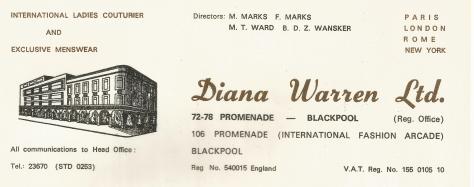
Dianna Warren had more than its fair share of show business luminaries within a clientele which included The Beverley Sisters, Kathie Kay, Val Doonican and actress Mollie Sugden who based her “Are You Being Served” character “Mrs Slocombe” on Betty Wansker who was the manageress at Dianna Warrens.
With the death of Mr Marks in 1980 Diana Warrens ceased to trade in The Arcade and in more recent years the building has been used as the ‘Cahoots’ Night Club and is now currently in use as ‘Yates’s’ main Blackpool venue.
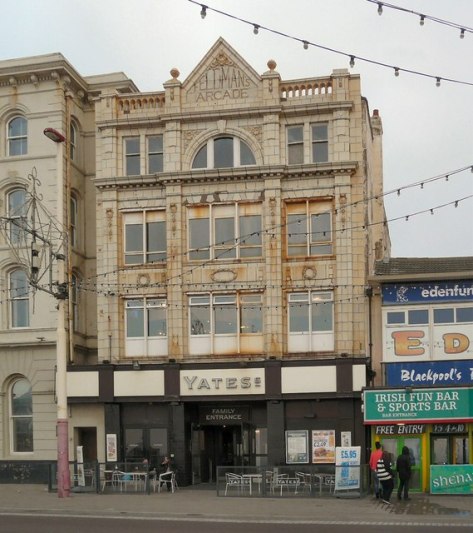
Feldman’s Arcade still stands proud as an epitaph to the achievements of its original owner and is symbolic of a defining era within the evolution of popular music in post First World War Britain. Even with it’s sadly neglected promenade frontage, it is certainly the last surviving music arcade which remains in Blackpool today and must surely qualify for preservation and listed status.



